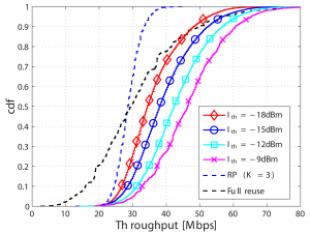Ghimire, B., and Haas, H., "Resource Allocation in Optical Wireless Networks", in "Proc. of the International Symposium on Personal, Indoor and Mobile Radio Communications (PIMRC 11)", IEEE, (Toronto, Canada), 11-14 September 2011, 5 pages (to appear).
We have applied the busy burst (BB) technique to an optical wireless networks deployed in an aircraft cabin. A user that has received data in a given frame and intends to continue receiving data in the next frame broadcasts BB in a time-multiplexed BB slot.
A neighbouring access point that intends to reuse the reserved resource listens to the BB slot and infers (prior to transmission) the amount of co-channel interference (CCI) it could cause towards the user that has reserved the resource, given that channel reciprocity holds. This is a vital information for an AP to decide without any central supervision whether to transmit or defer the transmission to another time or frequency slot so as to limit CCI caused to the active link to a threshold value. Compared to a static resource partitioning approach, it has been demonstrated that the median system throughput can be improved by 17% whilst maintaining roughly the same throughput at the cell-edge. Moreover, it is demonstrated that by adjusting the system wide threshold, the system throughput can be traded off to significantly enhance the throughput for the cell-edge users.
*Compared to static resource partitioning (RP) using a reuse factor of 3, the BB approach improves the median system throughput by 17% while maintaining an equivalent throughput at the cell-edge (details can be found in the paper).


